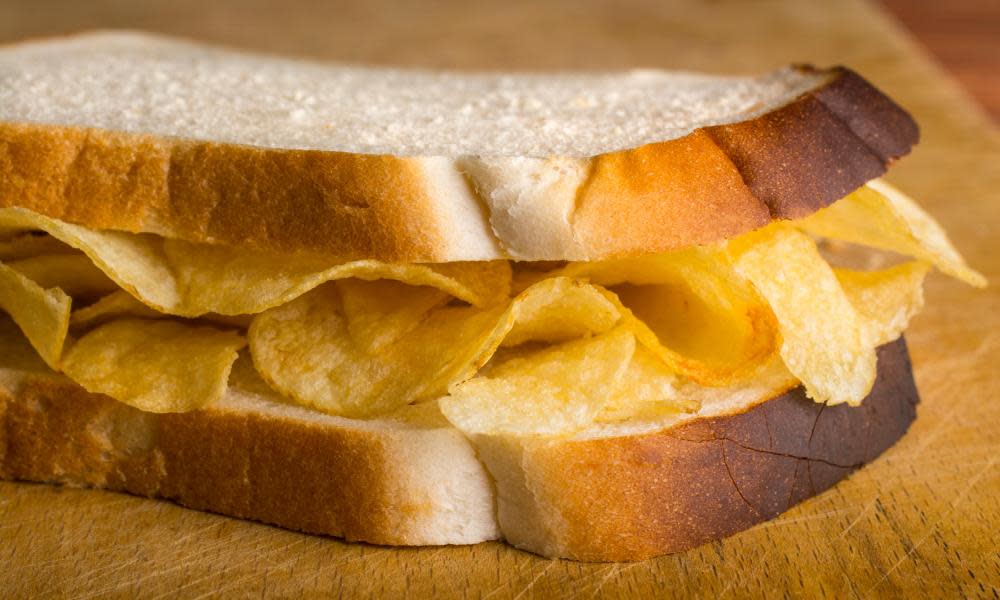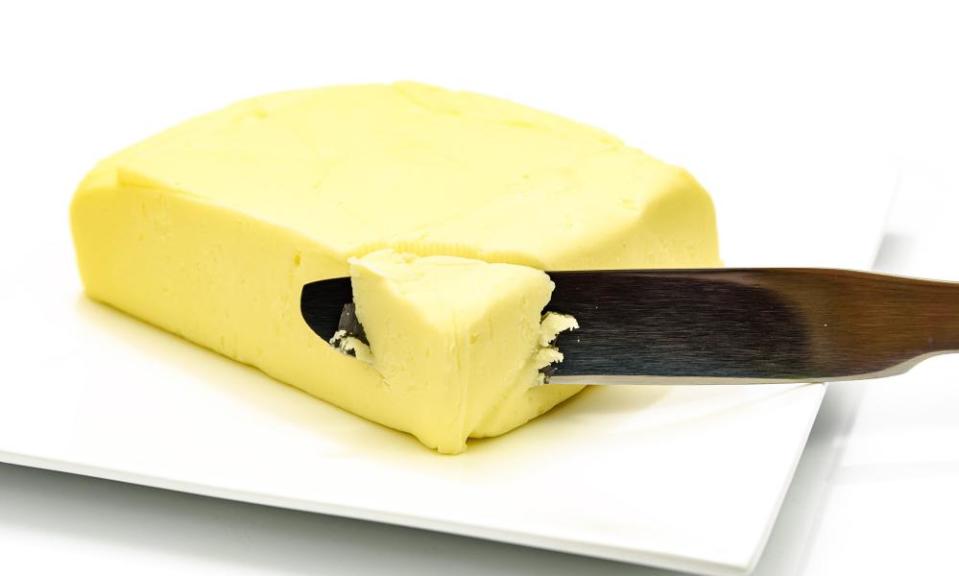How to eat: a crisp sandwich

The crisp sandwich is food’s equivalent of picking your nose. We all do it. Yes, even you. And, particularly in private, it can be a source of profound pleasure. But only rarely do you find a few brave souls – chapeau!, Jack Monroe, Nadiya Hussain and Emma Freud – willing to talk about it in public.
This is a processed-food item so persuasive that even a chef as organically handcrafted as Hugh Fearnley-Whittingstall cannot resist it (“It’s very hard to beat a good crisp sandwich.”), yet – bar that curious outbreak of crisp butty cafes in 2015 – we collectively neglect serious analysis of what makes it such a comfort-food classic. We are ashamed. Inhibited by snobbery. Waiting for a Spanish chef to deconstruct it or a hip Williamsburg diner to reassure us it is cool.
But who has time for that? At How to Eat – the series exploring how best to consume Britain’s favourite foods – there is no guilt, only pleasure. Therefore, let us settle once and for all on the crisp sandwich’s ultimate form.
Bread
Naturally, HTE is fully in favour of real bread – in the right circumstances. This is not one of them. Put the sourdough back. Step away from the worthy loaves. The crisp sandwich is meant to be an uninhibited pig-out, which will be ruined by using earnest wholemeal or ostensibly healthy seeded breads. Not only will their flavour jar horribly with the crisps, but the pious presence of those self-righteous seeds and grains will cast an anxious pall over proceedings, as if the bread is judging your filling and finding it wantonly gluttonous.
Instead, you need a mass-produced white sliced loaf that, in its milky blandness, will offer more cushioning texture than flavour. It should be a neutral delivery vehicle for your chosen crisp.
Not all supermarket loaves are created equal, however. Many are as light and airy as packing foam, with none of its durability. These fragile breads fall apart at the first flash of a butter knife. Ideally, you want to forcibly squash the top layer of your sandwich down as you make it, to mould it around the crisps, so it neatly retains them as you eat. For that, you need relatively dense squishy bread, such as Jackson’s white bloomer or – if you can stomach the company’s £25,000 donation to the Conservative party in 2010 – perhaps the world’s best crisp-sandwich bread, Warburtons toastie loaf.
If using a less politically compromised cob, bap or roll, avoid those with firm crusts that require you to tear at them. You will scatter crisp shrapnel everywhere. In that regard, a baguette is the least-practical crisp sandwich bread. Do not think about toasting your bread. This is already a dry sandwich.
Spread
Like many of the best things in life, a crisp sandwich needs lubrication. Ultimately, you will slather your slice with what you can afford. Margarine does a job, particularly on a crisp sandwich. It oils the wheels of mastication without positively boosting flavour. But if you do have a pound or three spare, HTE is unbending in its view that butter is one of the best investments in the supermarket chiller cabinet. Yes, its rich creaminess is a marginal gain in this context. But what is the pursuit of perfection if not the painstaking accumulation of such gains?

The idea that on a crisp butty of all things, you would deny yourself butter on health grounds and instead subject yourself to one of the light ’n’ spreadable, sterol-and-stanol, I-never-believed-it-wasn’t-butter-vegetable-oil options is baffling. You. Are. Eating. A. Crisp. Sandwich. The boat has sailed on blood pressure. Its salt levels will be unacceptable to all medical professionals. Your arterial health is an accident waiting to happen. We are dying. Every day. Embrace that reality or this endeavour will have been a comparative waste of time. And calories. For a diminished flavour payoff.
The crisp sandwich is an all-in, sod-the-consequences commitment. For instance, there are multiple things wrong with this Sainsbury’s recipe (onion, tomato, gherkins, salad leaves!), but perhaps the worst is its use of unsalted butter. On a crisp sandwich. In health terms, this is the dictionary definition of a false economy.
Crisp
HTE refuses to get into an argument about whether extruded corn snacks are crisps or not. It will not indulge Pringles pedants, who refuse to acknowledge a product consisting of rice flour and wheat starch mixed into a dehydrated potato base. Instead, HTE takes the following highly unscientific position: is it in the crisp aisle in the supermarket? Then it is a crisp. Yes, even the nuts and Mini Cheddars.
That settled, surely we can all agree that “fluffy” crisps – Monster Munch, Skips, spicy Nik Naks, Quavers, Chipsticks, generic cheesy balls – have no role to play in a crisp sandwich? The flavour intensity of Wotsits makes them tempting, and Frazzles taste more like bacon than bacon. But you need a crisp that offers a definitive crunch and clear textural contrast here. Not corn snacks that, when sandwiched between two slices of bread, produce what feels like a mouthful of cotton wool.

Fluffy crisps share that dehydration issue with, at the other extreme, Doritos, Scampi Fries and Mini Cheddars. Yes, they all pack plenty of crunch, but they lack the palpable easy-eating greasiness of mainstream crisps. A Mini Cheddar sandwich turns to claggy putty in the mouth. You would need several pints of water to get it down.
For different reasons, HTE is also ruling out posher “hand-cooked” crisps in the Kettle sphere and upwards. Generally, they are too thick and rigid in a sandwich (yes, there is such a thing as too crunchy) and, in the case of Tyrells, their pure flavours create a psychological dissonance. In a crisp sandwich, you do not want crisps that actually taste of the advertised ingredients. If you wanted a cheesy flavour, you would make a cheese sandwich. Rather, you want that lab-refined synthetic cheese-style cheese-and-onion flavour profile that, while it owes little to nature, wows on its own terms.
That is the curious paradox at the heart of the crisp sandwich: it works best when you add crisps that mimic sandwich ingredient flavours, so roast chicken, salt and vinegar (chip butty), smoky bacon or cheese and onion, rather than sweet chilli or prawn cocktail. But you also want those flavours delivered at the heightened, entirely artificial, level of intensity that only the cleverest boffins of the food-industrial complex can achieve using ingenious combinations of yeast extract, citric acid, garlic powder, dried cheese “cheese flavour” and umami disodium 5’-ribonucleotide.
The crisp-sandwich-filling sweet spot, then, is to be found in a mainline bag of Walkers (other brands are available) or, another marginal but important gain, in slightly thicker ridge-cut crisps such as Seabrook ascending to the – fans self! – positively hunky McCoy’s. Firm and muscular, yet given to melting greasily in the mouth, the all-powerful salt and vinegar McCoy’s is, perhaps, the ultimate crisp sandwich filling.
Note: never use ready-salted crisps. Too parsimonious. There isn’t a war on. Yet.
Sauces
In short: no.
If you are going the full home-cooked-potato-sandwich hog, different rules apply. But it is incredibly difficult to sparingly apply Tommy K or hot sauce without drowning the crisp’s flavour. You are now eating a ketchup or hot sauce sandwich with crunchy bits. That is wrong.
If the butter has been applied liberally enough (if not, why not?), there should be no need for mayonnaise, much less salad cream. Regular readers will know that HTE is unapologetically proud of its working-class origins. But a certain reverse snobbery attaches itself to salad cream. Salad cream is the point at which clinging to your roots reveals a debilitating lack of ambition and curiosity, and a refusal to conceive of a wider world of possibilities.
Additions
Is it shame, embarrassment or a desperate need to create new content that inspires advice on how to “pimp” a crisp butty or “take your crisp sandwich game to the next-level”? HTE cannot say.
Related: How to eat: a steak sandwich
What it does know is that most of the commonly added extras – cold, clammy ham; thick, gluey peanut butter; overpoweringly vinegary pickles – actively detract from the sandwich. As do attempts to give it a gourmet spin. The crisp sandwich does not need brie, bacon jam or rocket. Or caviar. It does not need to justify itself on foodie terms. Go down that route – as per Burts steak and stilton recipe with sea salt and peppercorn crisps – and the crisps soon become a mere seasoning on an entirely different sandwich. That is, as the late Amy Winehouse used to like sliced on top, bananas.
A little extra-mature cheddar brings greater depth to a cheese-and-onion crisp sandwich, but even that it is far from essential.
Equipment
A plate. Or the Hoover. You will need one. Possibly both.
Drink
Curiously (it’s the bread), while HTE would never eat a bag of crisps with a brew – that requires beer or cola – the crisp sandwich cries out for a steaming mug of something brick red and deeply tannic that you could plot on axes labelled Yorkshire Tea and M&S Extra Strong.
So, the crisp sandwich: how do you eat yours?

 Yahoo News
Yahoo News 
